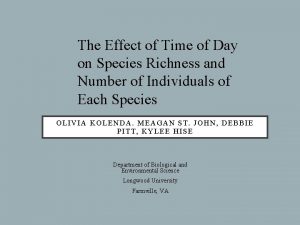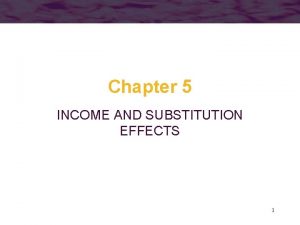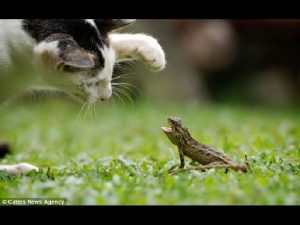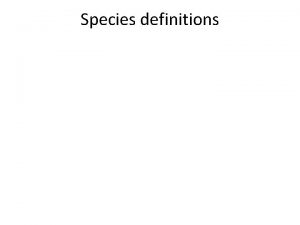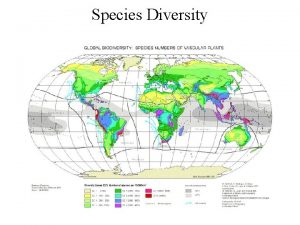The Effect of Time of Day on Species




















- Slides: 20

The Effect of Time of Day on Species Richness and Number of Individuals of Each Species OLIVIA KOLENDA. MEAGAN ST. JOHN, DEBBIE PITT, KYLEE HISE Department of Biological and Environmental Science Longwood University Farmville, VA

BACKGROUND • Wild birds follow a regular daily feeding activity. • Small birds present maximum activity of feeding during morning and evening. • Many factors may affect the time of caloric intake. (Morton 1967)

Feeding Pattern of White-Crowned Sparrows (Morton 1967)

TOTAL NUMBER OF BIRDS BASED ON TIME OF DAY (Rollfinke 1990)

SPECIFIC AIM • Does time of day affect the total number of birds? • Does time of day affect the species richness of birds? • To test this, we studied a specific bird feeder behind the EEC in Lancer Park.

STUDY AREA: • Longwood University Environmental Education Center (EEC) in Lancer Park located in Farmville, VA. • Perimeters: The birds within close perimeters of the bird feeder are the ones that will be counted.

SPECIES LIKELY TO BE SEEN

HYPOTHESES • Ho 1: There is no difference in the species diversity and richness of birds at one feeder bird feeder located at the Environmental Education Center at Longwood University based on different times of day (morning, noon, and afternoon). • Ho 2: There is no difference in the number of individuals of each species of birds at one feeder located at the Environmental Education Center at Longwood University based on different times of day (morning, noon, and afternoon).

TYPE OF STUDY • Observational study of point counts • Treatment variables: • Time of day • Temperature • Response variables: • Diversity in bird population at feeder • Number of birds in each species

ADDITIONAL PARAMETERS: IN VIRGINIA • The average annual temperature is 13. 5 degrees Celsius (56. 3 degrees Fahrenheit). • The average high temperature for March is 15. 1 degrees Celsius (59. 18 degrees Fahrenheit). • The average low temperature for March is 0. 2 degrees Celsius (32. 36 degrees Fahrenheit).

METHODOLOGY Collecting Samples • The medium-height bird feeder, second from the left, will be studied at the EEC. • For each time of day, data was recorded for 10 minutes • One tally mark was recorded for each bird seen, according to species • Only birds approaching the feeder were accounted for • If a bird fled the area and then returned, it was tallied again


METHODOLOGY Collecting Samples • Birds will be identified using the Merlin Bird ID app on mobile devices • Data will be statistically analyzed by ANOVA tests and Tukey Honestly Significant Differences tests • Point count is the method used for bird counting

NUMBER OF SPECIES OF BIRDS PRESENT BASED ON THREE DIFFERENT TIMES OF THE DAY. 4. 5 Number of speceis 4 3. 5 3 2. 5 2 1. 5 1 0. 5 0 9 AM 12 PM 4 PM

TOTAL NUMBER OF BIRDS PRESENT BASED ON THREE DIFFERENT TIMES OF THE DAY. Total number of birds 25 20 15 10 5 0 9 AM 12 PM 4 PM

THE EFFECT OF TEMPERATURE ON TOTAL NUMBER OF BIRDS PRESENT. Total number of birds 35 30 25 20 15 10 5 0 0 2 4 6 8 10 12 14 Temperature (degrees Celsius) 16 18 20

THE AVERAGE DOMINANCE PRESENTED BY DIFFERENT BIRD SPECIES BASED ON THE TIME OF DAY. 2. 5 Dominance (D) 2 1. 5 1 0. 5 0 9 AM 12 PM 4 PM

THE HETEROGENEITY PRESENTED BY DIFFERENT BIRD SPECIES BASED ON THE TIME OF DAY. 2 Heterogeneity (H') 1. 8 1. 6 1. 4 1. 2 1 0. 8 0. 6 0. 4 0. 2 0 9 AM 12 PM 4 PM

LITERATURE CITED Rollfinke, B. , & Yahner, R. 1990. Effects of Time of Day and Season on Winter Bird Counts. The Condor. 92(1): 215 -219. O'Leske, D. , Robel, R. , & Kemp, K. 1997. Fall Point Counts: Time of Day Affects Numbers and Species of Birds Counted. Transactions of the Kansas Academy of Science. 100(3/4): 94 -100.

THANK YOU!!! • Dr. Henk • Department of Biological Sciences • Longwood University
 Day 1 day 2 day 3 day 4
Day 1 day 2 day 3 day 4 Day 1 day 2 day 817
Day 1 day 2 day 817 A keystone
A keystone Effect of time of day on bird activity
Effect of time of day on bird activity Endangered animal poster project
Endangered animal poster project Example of elapsed time
Example of elapsed time The gradual change in a species over time
The gradual change in a species over time Gradual change
Gradual change Bohr effect in respiration
Bohr effect in respiration Founder effect vs bottleneck effect
Founder effect vs bottleneck effect Marshallian demand function
Marshallian demand function William beanes elementary school
William beanes elementary school Oceans apart day after day
Oceans apart day after day Day to day maintenance
Day to day maintenance Physical science chapter 6 review answers
Physical science chapter 6 review answers I don't know about tomorrow
I don't know about tomorrow Timeline for acts i-iii
Timeline for acts i-iii Growing day by day
Growing day by day Seed germination inhibitors examples
Seed germination inhibitors examples Seed germination conclusion
Seed germination conclusion Observation of plant growth day by day
Observation of plant growth day by day



